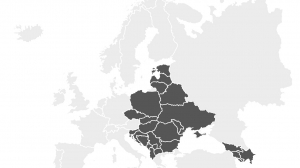ICT outsourcing is inevitable. Costs are going up, talent is becoming harder to find in mature and developed markets, offshoring/nearshoring are the way forward. There is a plethora of markets to choose from. IT outsourcing is huge in Asia, Europe and other parts of the world. However, in the hope of keeping costs down, it is easier to outsource closer to home.
That said, one of the fastest growing sectors in emerging Europe is IT outsourcing. There are a myriad of reasons for this, for example the fact that markets in Central and Eastern Europe (CEE) are only a few hours away by flight from their key markets in Europe, there is also a cultural aspect, people from CEE share in the same culture and traditions as most western European countries. In addition to that, emerging Europe countries for the most part are in a similar time-zone to the rest of Europe.
Eastern Europe is one of the best places for software development, the sector has seen significant growth in the last few years, not to mention the fact that countries are investing heavily into IT infrastructure as well as creating special programmes to promote the advancement of the sector. Countries like Ukraine, Poland, Hungary, Belarus, and Romania have already defined IT as a major catalyst for their sustainable growth and technological advancement.
Deloitte’s analysis of the global market
According to Deloitte’s Global Outsourcing Survey 2018, there were three major trends that increased outsourcing globally. The findings of the 2018 survey show a significant shift from Deloitte’s findings from 2016.
Then, the survey had already established that there was a shift occurring and that outsourcing was more than a simple cost saving solution. However, in the 2018 report one of the key trends as we read is that outsourcing is enabling competitive advantage:
“While cost optimisation is still a critically important criterion for outsourcing, it is no longer at the top of the list (nor even in the top five), since disruptive outsourcing, when executed well, can deliver competitive advantage by transforming the way organisations operate, and making them more agile, efficient, and effective. The advantages are obvious to respondents: approximately 84 per cent of them have either initiated discussions, conducted pilots, or have implemented at least some disruptive solutions,” reads the report.
Another interesting finding in is that organisations are embracing disruptive outsourcing technologies such as cloud and robotic process automation (RPA)
“The vast majority of organisations—93 per cent—are considering or adopting cloud solutions and 72 per cent are considering or adopting RPA solutions. Seventy per cent of respondents believe their service providers have a reasonable or advanced ability to implement disruptive solutions.”
In other words, the new trend is a move to cloud based solutions, with a key focus on innovation and choosing providers that will help provide innovative solutions and keep your company ahead of the pack. As the report suggests and is titled: Traditional outsourcing is dead. Long live disruptive outsourcing.
Doug Plotkin, managing director of Deloitte Consulting LLP writes: “In the past, organisations typically used outsourcing to improve back-office operations through cost reduction and performance improvement. Today, disruptive outsourcing solutions are enabling competitive advantage by accelerating changes within those organizations that have the audacity and skill to leap over the technology chasm… The focus has shifted from traditional work transfer to upfront transformation and automation. Organizations are recognizing that disruptive solutions can revolutionise the way they do business, and that buying capabilities in the marketplace is generally faster and more scalable than developing capabilities internally. Emerging solutions incorporating cloud and automation are empowering organizations to work smarter, scale faster, reach new markets, increase productivity and, ultimately, to gain competitive advantage.”
While the report would suggest that traditional outsourcing is a thing of the past it does highlight the fact that there are real challenges with adopting disruptive solutions: “Data migration, security requirements, and application optimisation/change are just a few examples of challenges related to cloud adoption. Organisational resistance, highly fragmented processes, and regulatory restraints are common challenges related to RPA adoption.”
What does this mean for emerging Europe?
The region is quickly adapting to new trends and are ahead of the game in terms of innovation. The region is embracing 5G technology and in many ways are at the forefront of implementing said technologies. Orange Polska have begun outdoor trials of their 5G equipment in September 2018, Romania boasts one of the fastest internet speeds in the world, and Lithuania lays claim to having the fastest public WiFi in the world. Investments and the development of RPA are also becoming more popular in the region, with Romania being on of the countries ahead of the rest.
Several markets in the region have grown and developed very well over the years, and some are beginning to take off. Based on the different rankings out there and how scores are calculated the results vary based on the various criteria being measured. One thing is certain, countries in emerging Europe have a huge talent pool, and are among the top countries in Europe and globally according to some rankings. However, a common theme is that the following countries have had a huge impact on the growth of ICT in the region: Belarus, Bulgaria Czech Republic, Estonia, Hungary, Latvia, Lithuania, Poland, Slovakia, Romania and Ukraine.
Grzegorz Borowski, co-founder of InfoShare tech conference, said to be the biggest tech conference in CEE, published a report in July 2018, which highlights just how diverse the region is as a whole: according to his report, there are roughly one million professional-grade software developers across CEE, which accounts for six per cent of global developers. In addition to the developer population they also look at the types of coding used in each country and how they compare to other parts of the world.
According to N-iX, a Ukrainian and Polish based provider of software development outsourcing services, Eastern Europe remains one of the most attractive outsourcing destinations due to the constant growth of the IT industry and strong technological expertise. Based on their analysis, countries such as Ukraine, Poland and Romania are taking the lead when it comes to the software development market. Countries like Bulgaria, and Belarus may be falling behind market leaders in terms of innovation adoption and overall technological capacity however they have introduced a number of incentives to foster IT industry development. On the other hand, Baltic countries have launched a number of e-programs and have created a favourable business environment in the region. One of their key takeaways is that: IT outsourcing in the region is viewed as a major business enabler of digital transformation rather than just an attractive cost-cutting option.
In the world of ICT outsourcing as well as in many other walks of life, research indicates that there is no such thing as one-size fits all, each client will have different requirements, and the talent in one country in the region may not be a perfect fit compared to another.
The region is diverse and each of the markets do have different specialisations when it comes to the talent pool, some are strong with Java, and others with PHP or Python. Whatever the needs are the emerging Europe region can cater to them.






[…] https://emerging-europe.com/intelligence/it-outsourcings-new-wave/ […]
[…] https://emerging-europe.com/intelligence/it-outsourcings-new-wave/ […]
[…] https://emerging-europe.com/intelligence/it-outsourcings-new-wave/ […]
[…] https://emerging-europe.com/intelligence/it-outsourcings-new-wave/ […]
[…] https://emerging-europe.com/intelligence/it-outsourcings-new-wave/ […]
[…] https://emerging-europe.com/intelligence/it-outsourcings-new-wave/ […]